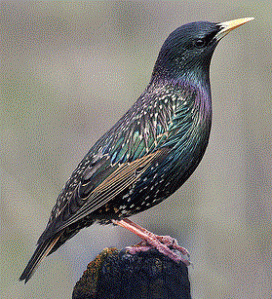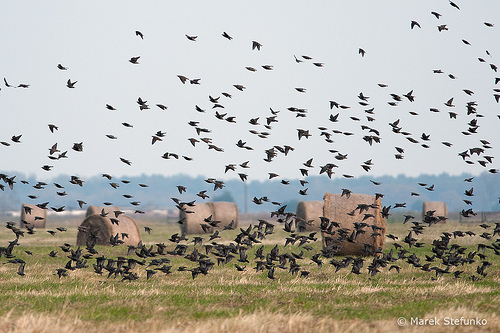Avian rats? Why do we mortals favor some critters over others? Perhaps some wondered, when I said in reference to the squirrels that came to eat the corn I placed for birds, "squirrels have to eat, too." Dog food certainly is popular with birds. So why did I find myself rapping on the window to frighten away the starlings that had come to feed? Starlings have to eat, too.
It surprised me that the blue jays were intimidated by the starlings. I expected the saucy jays to be dominant. When I rapped on the window, three jays that had been driven off the ground into the tree, descended to feed where the starlings had just departed.
Cardinals with their bright colors delight the eye which probably attests to their popularity. Blue jays, too, are brightly colored. But my animus toward starlings, how to understand? They're imported but so are pheasants. So I googled "Starling" and this is what I found.
"None other than the European starling, Sturnus vulgaris.

Surprising? Why is a European songbird one of the most common birds in the northeastern USA? It goes back to one man’s love of Shakespeare, and that old institution of biological imperialism: the American Acclimatization Society.
First established in 1871, the American Acclimatization Society sought to introduce European flora and fauna to the American continent. Of course, acclimatization societies were not unique to the United States. In fact, many of the former English colonies had them (Australia having the most prominent examples in my mind, along with Canada and New Zealand.) In each case, English settlers of these Neo-Englands wanted to recreate the aesthetic and recreational pastimes of their British origins–by introducing familiar plants and animals. After all, how could the former Englishmen go fox-hunting in places like Australia without proper foxes?
Of course, the American Acclimatization Society had more pressing ideas on its mind. Great literature, for instance. In 1877, Eugene Schieffelin, a wealthy drug manufacturer, became chair of the society. In a romantic, if completely absurd, effort, Mr. Schieffelin tried to introduce to the USA every bird species ever mentioned in Shakespeare’s collected works. And unfortunately for the local flora and fauna–the Bard mentions the starling once (just once in all of his writings!) in Henry IV, Act I:
So in 1890, in the middle of Central Park, Eugene Schieffelin loosed 60 imported starlings into New York City. The next year, he introduced over 40 more. Just 20 years later, the birds were well-established along the east coast. By 1942, they could be found across the entire continent. Now, the starling is one of the most common birds in the U.S.–and all the starlings in the country are descendants of those first few introduced birds. I should note though, that there’s no way Schieffelin could have understood the scope of what his society was doing. The word ‘ecology’ was coined only two decades before the release of the starlings–and the field was nowhere near what it is today. (It’s probably only through the examples of the starling, and perhaps, the cane toad, that humans figured out studying ecology might be of some value).
According to the U.S. Department of Agriculture, the starling both competes with native species, and destroys crops. Nominated to the list of the Top 100 “World’s Worst Invasive Species”, it’s estimated that starlings do over $800 million of agricultural damage each year. Much of this damage is due to the bird’s voracious appetite for cattle feed and our own food crops. They spread disease among livestock, as well.

In addition to eating everything in sight, starlings’ roosting habits also cause problems. By living in groups of up to 10,000 or more individuals–and often living near airports–starlings are responsible for about 6% of bird-aircraft strikes, and pose a serious problem for airport maintenance.
To be honest, I’m surprised starlings haven’t done more damage to indigenous bird species populations. Though they do compete with native cavity-nesting birds, at least one study says the starlings haven’t had too much of an impact on the native birds…. (I’m not sure I believe that, though.)
Undoubtedly the USDA and a horde of angry farmers will keep calculating the damage done by these birds–probably not in my hometown, anyway. And they all have the American Acclimatization Society, Mr. Schieffelin, and William Shakespeare to thank."
Perhaps I'll continue to rap on the kitchen window.
Takk for alt,
Al
A place in Bangkok where I've had a haircut. 😀

No comments:
Post a Comment